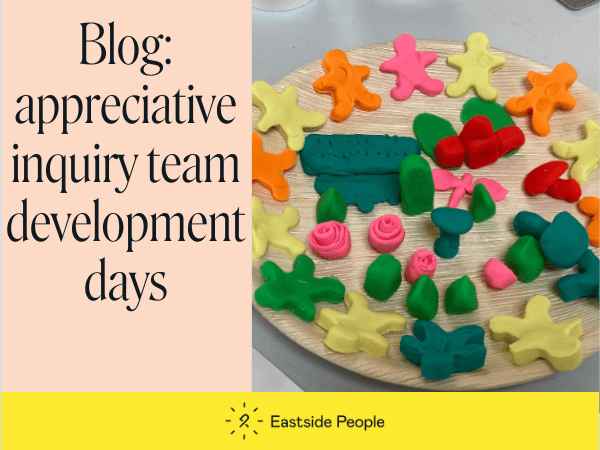Measuring impact through social value
By Eastside People Consultant Alastair Tallon.
Introduction
In today’s rapidly changing society, organisations are increasingly expected not only to deliver financial returns or outputs, but also to create lasting, positive changes for people, communities, and the environment. The concept of “social value” – the broader, often intangible benefits stemming from an organisation’s activities – has emerged as a vital lens through which to measure true impact. Far surpassing mere financial metrics, social value provides a holistic understanding of how interventions, services, or investments transform lives and societies. This article explores the rationale behind social value measurement, its methodologies, challenges, and the profound benefits it offers to organisations and their stakeholders.
What is Social Value?
At its core, social value refers to the non-financial impacts generated by an organisation’s actions – impacts that affect the wellbeing of individuals, the vibrancy of communities, and the health of our planet. Where traditional evaluation might focus on jobs created or profits earned, measuring social value asks: How do our actions improve quality of life? How do they foster social inclusion, promote environmental sustainability, or enhance public trust?
Social value is not limited to the charitable sector. Increasingly, governments, businesses, and social enterprises are seeking to understand and communicate the broader outcomes of their work. In the UK, the Social Value Act of 2012 enshrined the importance of such considerations in public sector procurement, requiring commissioners to consider how services being commissioned might improve the economic, social, and environmental wellbeing of the area.
Why measure Social Value?
1. Beyond numbers: telling the whole story
Traditional measurements – such as outputs, profit margins, or service uptake – provide only a partial picture. Social value measurement uncovers the ripple effects that extend far beyond initial goals. For example, a job training programme may report 200 graduates, but the social value lens seeks to understand the long-term increase in confidence, reduction in social isolation, or ripple effect on families and communities.
2. Accountability and transparency
In an era where funders, investors, and government bodies increasingly demand evidence of impact, social value measurement offers a robust foundation for accountability. It enables organisations to demonstrate not only what they do, but the difference they make – building trust with stakeholders and justifying investment.
3. Informing decision-making
By quantifying and articulating social value, organisations are better equipped to allocate resources, design effective interventions, and prioritise activities that maximise positive outcomes. This evidence-based approach to strategy drives more targeted, impactful action.
How to measure social value: approaches and frameworks
Measuring social value can be complex, given its multidimensional and sometimes subjective nature. However, a growing number of frameworks and tools enable organisations to translate intangible benefits into meaningful data.
Social return on investment (sroi)
SROI is a widely used methodology that seeks to quantify social value in monetary terms where possible. It follows a structured process:
- Identify stakeholders: Engage with all those affected by the intervention
- Map outcomes: Understand and describe the changes experienced
- Evidence outcomes: Collect qualitative and quantitative data
- Value outcomes: Assign financial proxies to outcomes that are not traded in markets (e.g. improved confidence, reduced loneliness)
- Calculate SROI ratio: Compare the total value created to the investment required.
While not perfect, SROI offers a powerful narrative to complement traditional reporting, translating stories of change into numbers that resonate with funders and policymakers. However, by introducing financial proxies as a way of defining outcomes can be challenging when ascribing a £ value to an intangible or long-term outcome such as increased self-esteem, or improved engagement with support services.
Qualitative and mixed-methods evaluation
While numbers are persuasive, stories remain powerful. Many organisations blend quantitative data with case studies, interviews, and participant observation to capture the nuanced ways their work creates value. This can include:
- Case studies of individual journeys
- Focus groups and stakeholder feedback
Theory of Change
A well-articulated Theory of Change can serve as the backbone of social value measurement. By mapping how activities lead to outputs, outcomes, and impact, organisations clarify what to measure and why. This clarity helps ensure data collection is purposeful and aligned to strategic goals.
Challenges in measuring Social Value
Despite its advantages, measuring social value is not without obstacles:
- Attribution and Contribution: It is often difficult to isolate the effects of a single intervention, as real-world outcomes may result from multiple factors.
- Selection of Indicators: Choosing relevant, meaningful indicators that reflect the lived experience of stakeholders can be challenging.
- Monetisation of Intangibles: Assigning financial proxies to outcomes like wellbeing or social cohesion can be contentious and relies on subjective judgement.
- Risk of Oversimplification: Reducing complex changes to a single metric may ignore important nuances.
- Resource Intensity: High-quality social value measurement may require significant investment in data collection, analysis, and stakeholder engagement.
Best Practice in Social Value Measurement
To maximise the value and credibility of social value assessments, organisations should:
- Engage Stakeholders: Involve those affected in defining what matters and how value is created
- Use Mixed Methods: Combine quantitative measures with qualitative insights to capture the full range of outcomes
- Be Transparent: Clearly explain methodologies, acknowledge limitations, and avoid overstating impact
- Align Measurement with Strategy: Ensure social value metrics are aligned to organisational aims and inform decision making.
Case Study: Social Value in Action
A housing association is aiming to reduce social isolation among older tenants. Instead of focusing only on the number of social events held, the association measures:
- Changes in self-reported loneliness and wellbeing
- Increased community participation and volunteerism
- Downstream effects, such as reduced GP visits or hospital admissions.
Conclusion
By using a Social Value Framework, organisations can highlight its impact across a number of different areas including improved mental health & wellbeing or greater community engagement and resilience. Interviews and case studies provide a human face to these statistics, sharing stories of renewed confidence and friendships that numbers alone cannot capture.
At its heart, social value is about people: their experiences, hopes, and the changes that matter most to them. The most effective measurement systems are those that stay grounded in lived reality, listening carefully and adapting to what is truly valued by stakeholders.
Measuring social value is both an art and a science – a process that blends evidence and empathy, data and dialogue. By embracing this broader perspective, organisations unlock a deeper understanding of their impact, foster stronger stakeholder relationships, and create a compelling case for their continued existence and support. In a world increasingly focused on outcomes rather than outputs, social value is not just a metric; it is the meaning behind the mission.










